

Edward I of England. Edward I (17 June 1239 – 7 July 1307), also known as Edward Longshanks and the Hammer of the Scots (Latin: Malleus Scotorum), was King of England from 1272 to 1307.

The first son of Henry III, Edward was involved early in the political intrigues of his father's reign, which included an outright rebellion by the English barons. In 1259, he briefly sided with a baronial reform movement, supporting the Provisions of Oxford. After reconciliation with his father, however, he remained loyal throughout the subsequent armed conflict, known as the Second Barons' War. After the Battle of Lewes, Edward was hostage to the rebellious barons, but escaped after a few months and joined the fight against Simon de Montfort.
Montfort was defeated at the Battle of Evesham in 1265, and within two years the rebellion was extinguished. He spent much of his reign reforming royal administration and common law. Edward I - Wars of Independence. Edward ruled England from 1272 to 1307.
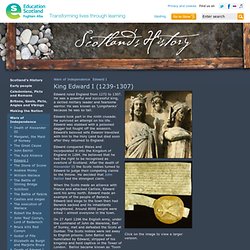
He was a powerful and successful king, a skilled military leader and fearsome warrior. He was known as ‘Longshanks’ because he was so tall. Edward took part in the ninth crusade. He survived an attempt on his life. Edward was stabbed with a poisoned dagger but fought off the assassin. Edward conquered Wales and incorporated it into the Kingdom of England in 1284. When the Scots made an alliance with France and attacked Carlisle, Edward sent his army north. Scotland's History - Edward I, King of England. History - Historic Figures: Edward I (1239 - 1307) Edward I Biography. King Edward I: England's Warrior King. A case can be made that Edward I was the greatest English king of the Middle Ages.
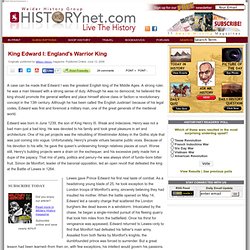
A strong ruler, he was a man blessed with a strong sense of duty. Although he was no democrat, he believed the king should promote the general welfare and place himself above class or faction–a revolutionary concept in the 13th century. Although he has been called 'the English Justinian' because of his legal codes, Edward was first and foremost a military man, one of the great generals of the medieval world. Edward was born in June 1239, the son of King Henry III. Weak and indecisive, Henry was not a bad man–just a bad king.
Lewes gave Prince Edward his first real taste of combat. Eventually Edward escaped, joined forces with Roger Mortimer, Earl of Gloucester, and together they defeated Simon de Montfort at Evesham on August 4, 1265. Once, when Edward was resting in his tent, a Muslim assassin broke in and attacked him with a poisoned knife. The Plantagenets > Edward I. Edward I 'Longshanks' (r. 1272-1307) Born in June 1239 at Westminster, Edward was named by his father Henry III after the last Anglo Saxon king (and his father's favourite saint), Edward the Confessor.

Edward's parents were renowned for their patronage of the arts (his mother, Eleanor of Provence, encouraged Henry III to spend money on the arts, which included the rebuilding of Westminster Abbey and a still-extant magnificent shrine to house the body of Edward the Confessor). As a result, Edward received a disciplined education - reading and writing in Latin and French, with training in the arts, sciences and music. In 1254, Edward travelled to Spain for an arranged marriage at the age of 15 to 9-year-old Eleanor of Castile. King Edward I Longshanks. Family tree poster & books House of Plantagenet Family Tree Detailed Tree Scottish King or Queen FAQs.

Edward I, Longshanks. Edward I, nicknamed "Longshanks" due to his great height and stature, was perhaps the most successful of the medieval monarchs.
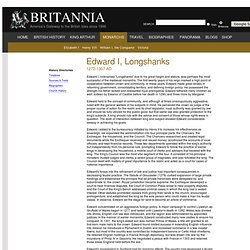
The first twenty years of his reign marked a high point of cooperation between crown and community. In these years, Edward made great strides in reforming government, consolidating territory, and defining foreign policy. He possessed the strength his father lacked and reasserted royal prerogative. Edward fathered many children as well: sixteen by Eleanor of Castille before her death in 1290, and three more by Margaret. Encyclopedia Britannica. Edward I, byname Edward Longshanks (born June 17, 1239, Westminster, Middlesex, Eng.

—died July 7, 1307, Burgh by Sands, near Carlisle, Cumberland), son of Henry III and king of England in 1272–1307, during a period of rising national consciousness. He strengthened the crown and Parliament against the old feudal nobility. He subdued Wales, destroying its autonomy; and he sought (unsuccessfully) the conquest of Scotland. His reign is particularly noted for administrative efficiency and legal reform. He introduced a series of statutes that did much to strengthen the crown in the feudal hierarchy. King Edward I. King Edward I AKA Edward Born: 17-Jun-1239Birthplace: Palace of WestminsterDied: 7-Jul-1307Location of death: Burgh on Sands, ScotlandCause of death: unspecifiedRemains: Buried, Westminster Abbey, London, England Gender: MaleRace or Ethnicity: WhiteSexual orientation: StraightOccupation: Royalty Nationality: EnglandExecutive summary: Conquered Wales, persecuted Jews.
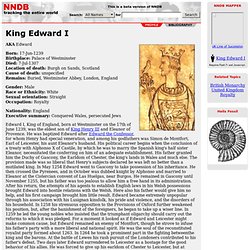
Edward I Longshanks. Early Years Often considered the greatest of the Plantagenets, Edward I was born on the evening of 17th June, 1239, at Westminster Palace, the first born child of Henry III and Eleanor of Provence.
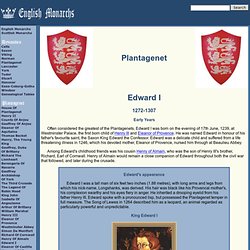
He was named Edward in honour of his father's favourite saint, the Saxon King Edward the Confessor. Edward was a delicate child and suffered from a life threatening illness in 1246, which his devoted mother, Eleanor of Provence, nursed him through at Beaulieu Abbey. King Edward I and York: History of York. Edward's reign began with the death of his father, Henry III, in 1272.
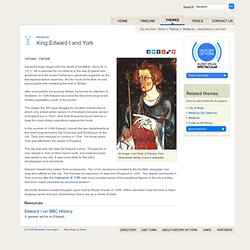
He is admired for his reforms to the way England was governed and the model Parliament, generally regarded as the first representative assembly. But for much of his time he was preoccupied with mastering the rest of Britain. After successfully conquering Wales, he turned his attention to Scotland. Edward Plantagenet, King of England (1239 - 1307. A short summary from Wikipedia: Edward I Longshanks Reign: 16 November 1272 – 7 July 1307 Coronation: 19 August 1274 Predecessor : Henry III Successor: Edward II Spouse: Eleanor of Castile m. 1254; dec. 1290 Margaret of France m. 1299; wid. 1307 among others Issue John Henry.
Death of Edward I - Wars of Independence. Edward I was one of England’s most formidable kings. At the age of 68, on his way north to once again deal with the troublesome Scots, Edward fell ill. He died at Burgh upon Sands in Cumberland on 7 July 1307. When Edward’s beloved Queen, Eleanor of Castile, died of fever in 1290 Edward had a series of elaborate carved stone crosses built to mark the route her body took from Lincoln to Westminster Abbey in London. Charing Cross in named for one of the ‘Eleanor Crosses’. Edward had fathered 17 children, including the heir to the throne Edward II, and was twice married. It is said that as Edward I lay dying he asked for his heart to be taken to the Holy Land and for the flesh to be boiled from his body so his bones could lead the English army in battle against the Scots. Edward’s body was buried in royal purple robes in Westminster Abbey.
King Edward I.